Leicester City pulled off a fairytale Premier League title win back in the 2015/16 season, with that Foxes team going down in not just English football history, but world football history as one of the unlikeliest champions ever. Since then, as expected, the regular contenders have wrested back the title, with Leicester finishing in 12th, 9th, 9th and 5th place up until the 2019/20 season. Two things become quite clear hear – one, that the Foxes have managed to become an established Premier League team, which is no mean feat, given that they only regained promotion to the Premier League in 2014, surviving relegation with a stirring run in the last few games of the 2014/15 campaign, which would be the prelude for their title win the next season. Secondly, we can immediately see the improvement from 9th to 5th place over the last two seasons, and the credit for this is largely due to Brendan Rodgers.
Rodgers arrived at the King Power Stadium in February 2019, after the removal of Claude Puel, and thus last season was his first full campaign in charge of the Foxes. He had them in the Champions League spots when the season was suspended due to the COVID-19 pandemic, and only a poor run of form upon the resumption of the season led to Leicester falling to fifth. However, it seems as though the team have picked up where they left off in 2019 this time around, as Leicester are in third place at the time of writing, just three points off the top of the table, with just around half the season having been played. Rodgers has managed to turn Leicester into a serious contender for the European spots, and even possibly for the title, and what is even more impressive is that he has done this with a considerable list of absentees for the majority of the campaign due to injury.
This tactical analysis piece will look at Leicester’s tactics so far this season, and how Rodgers’ strategies have allowed them to climb up the table in what will hopefully be a sustained assault on the Premier League title.
Statistical performance
Before looking at Leicester City’s tactics and set-up this season, it will be instructive to look at their statistical performance as well, to gain an understanding of what they are doing well, and where they need to improve.
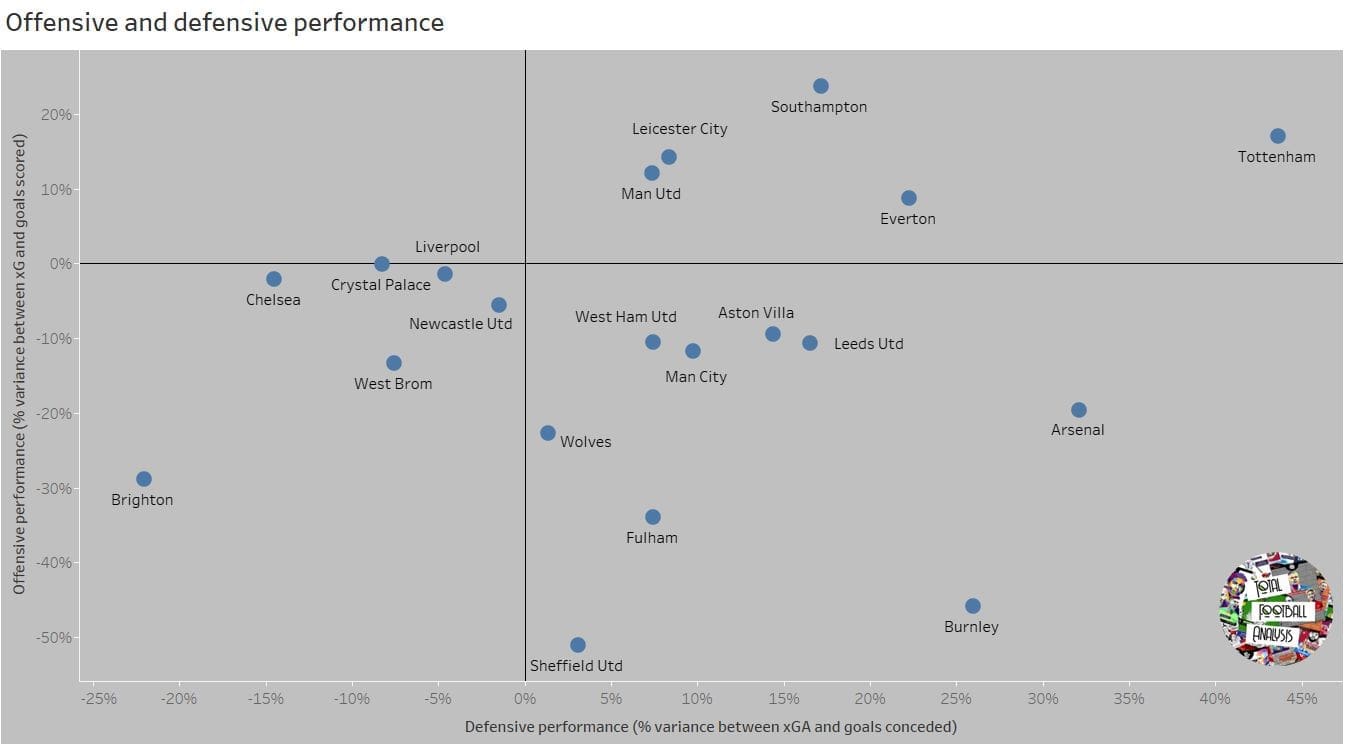
This chart looks at the defensive and offensive performance of Premier League sides so far this season, by looking at expected goals scored and conceded, against actual goals scored and conceded. We have calculated the % over or underperformance for each team, by looking at the difference between the expected and actual goal numbers. Looking at the chart, we can straightaway see that Leicester are among a handful of teams who are outperforming both their defensive and offensive xG numbers at the moment. Their defensive outperformance i.e the difference between goals conceded and xGA, is 8%, while their offensive outperformance is 14%. This is extremely favourable when compared to the likes of Manchester City, who are topping the table despite an offensive underperformance of 12%, and Liverpool, who are underperforming defensively and offensively by 5% and 1% respectively. The fact that City are at the top of the table despite their supposed goalscoring struggles is an ominous sign for the rest of the league, but this chart does show the excellent job that Rodgers has done in squeezing every last drop of performance from this squad. The Foxes may drop off a little as the season progresses, but they should be in the Champions League places at the very least if they manage to keep this level of performance till the end of the season.
However, there is one caveat to this. Leicester City may be outperforming on both defensive and offensive numbers, as far as expected goals are concerned, but there are some concerns around their creativity. The Foxes are eighth in the league for xG/game (1.61), but this includes the fact that they have received as many as 10 penalties this season, the highest in the league. Removing penalties from the equation to arrive at non-penalty xG (npxG) is a better way to gauge teams’ creativity and offensive output. Upon doing so, we see that Leicester actually fall to 13th for npxG/game (1.21), or, to put it the other way, they are the eighth-worst team in the league for creativity from open play, at least when measured through expected goals. This will be a concern for Rodgers, as it indicates that the Foxes could potentially have goalscoring problems as the season progresses, since they are not creating a high volume of quality opportunities. They are also not taking too many shots – Leicester have taken 10.43 shots/90 in the league this season, which is only the 11th-highest. However, their xG value per shot is at 0.144, while the average for the Premier League is around 0.13, suggesting that Leicester are taking shots from better positions than the average Premier League side, even if they aren’t taking too many of them. Of course, this does include their 10 penalties, which will each have an xG value of 0.76 associated with it, and this could be inflating their xG/shot numbers as well. Nevertheless, these numbers show that Leicester have been extremely efficient and clinical this season, and they will need to keep this up if they are to stay in the hunt for the Champions League, or even the title. One surprising aspect of this is the fact that while Leicester as a team are outperforming their xG, that is not the case for Jamie Vardy. The 34-year-old striker has scored 11 goals in the league thus far, against an xG of 12.79, and he does take penalties for Leicester when on the pitch, meaning that he has actually spurned a few chances this season. The likes of Harvey Barnes (6 goals from 4.85 xG), Youri Tielemans (4 goals from 3.10 xG), and most significantly, James Maddison (6 goals from 1.75 xG) are all doing much better than their xG, which would explain Leicester’s overall outperformance.
Defensively, it is a better story for the Foxes, as they have the fifth-best record for both goals conceded, as well as xGA. They are also conceding just 9.01 shots/90 at the moment, which is the sixth-best in the league so far, and in terms of xG/shot, they are at the league average, with 0.12 xG/shot conceded. These numbers point towards the defensive performance perhaps being more sustainable than the offensive outperformance, especially as Leicester are now seeing many of their injured defensive players return to fitness. It has been quite impressive that Leicester have managed to perform so well defensively despite the absence of so many key players, and our analysis of Rodgers’ tactics will show how he has especially managed to create a solid defensive system this season.
Defensive system
Brendan Rodgers has made a name as a coach who does have an overall philosophy of how he wants his side to play, but is open to making changes based on specific opponents and situations, as well as other factors such as injuries. It is for this reason that Leicester have largely played with a back three/back five this season, with a number of injuries to key defensive personnel to contend with. Nevertheless, the Northern Irishman has managed to put out a well-drilled and solid team despite this, with some players adapting to play in new positions to aid their team during this run.
Whether playing in a back three/five or with a back four, there are certain principles which have stayed consistent for Leicester this season. One of the primary aims has been to stay compact between the lines, and also defend the wide spaces well, with wide midfielders and even the central midfielders, on occasion, going out to the wider areas to support the full-back or wing-back, as the case may be. We can see this in the following examples, from games against Manchester City, Arsenal and Chelsea this season.
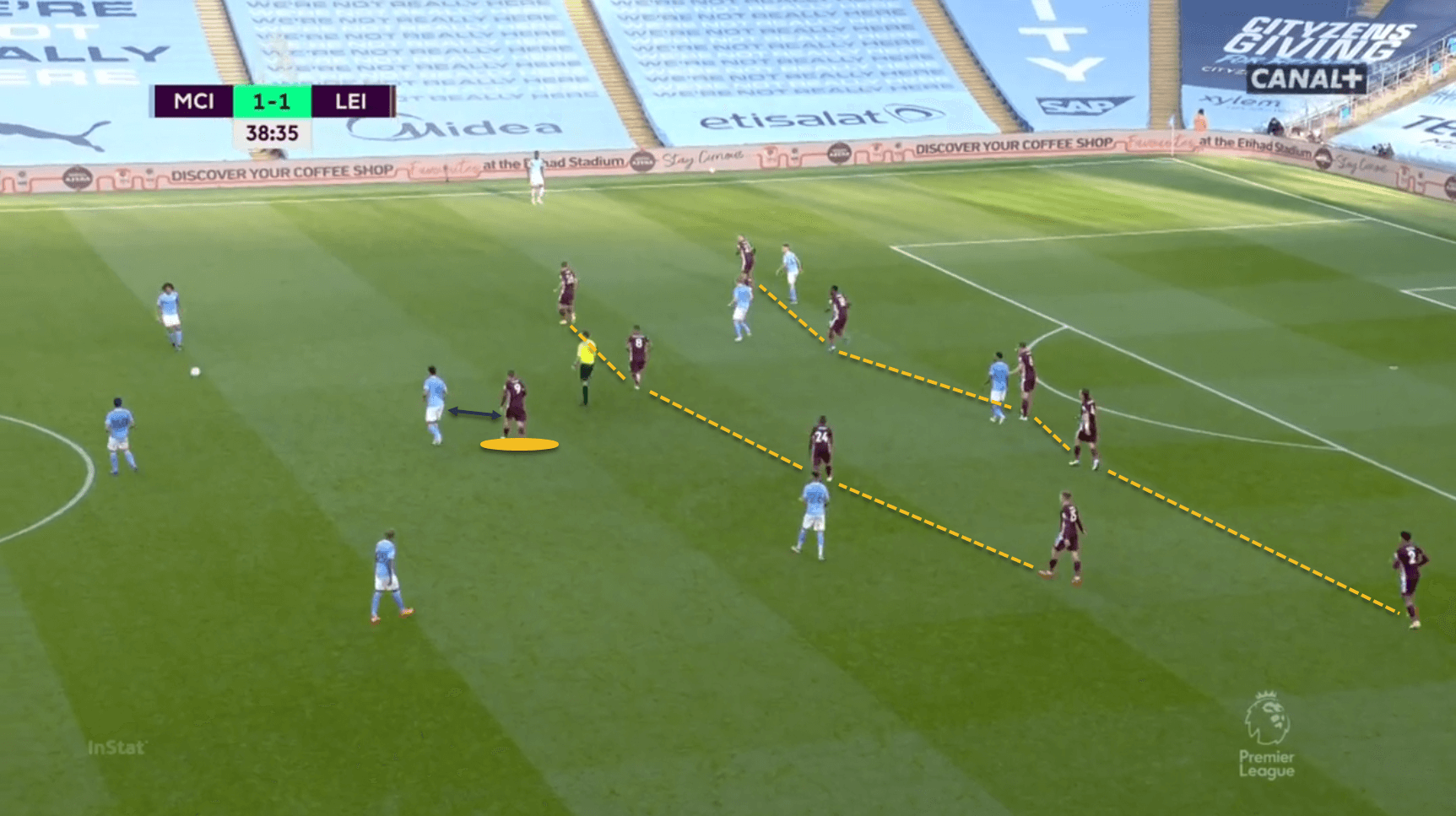
Note how close the Leicester defensive and midfield line is, as well as Vardy’s positioning close to Rodri to cut out a simple pass into him.
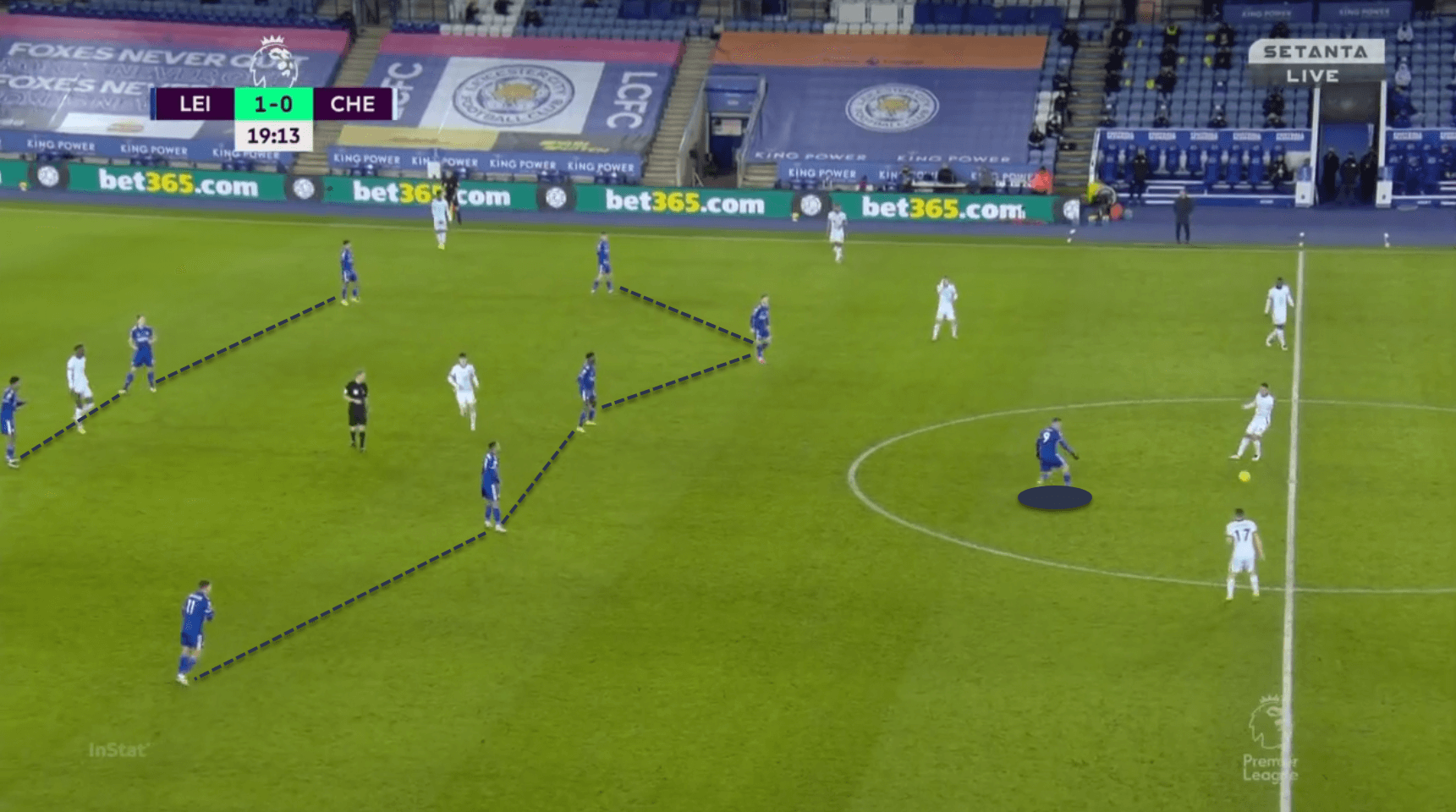
Here, Leicester are in a back four, but the same principles apply, with Maddison dropping into the midfield line to form a solid midfield block.
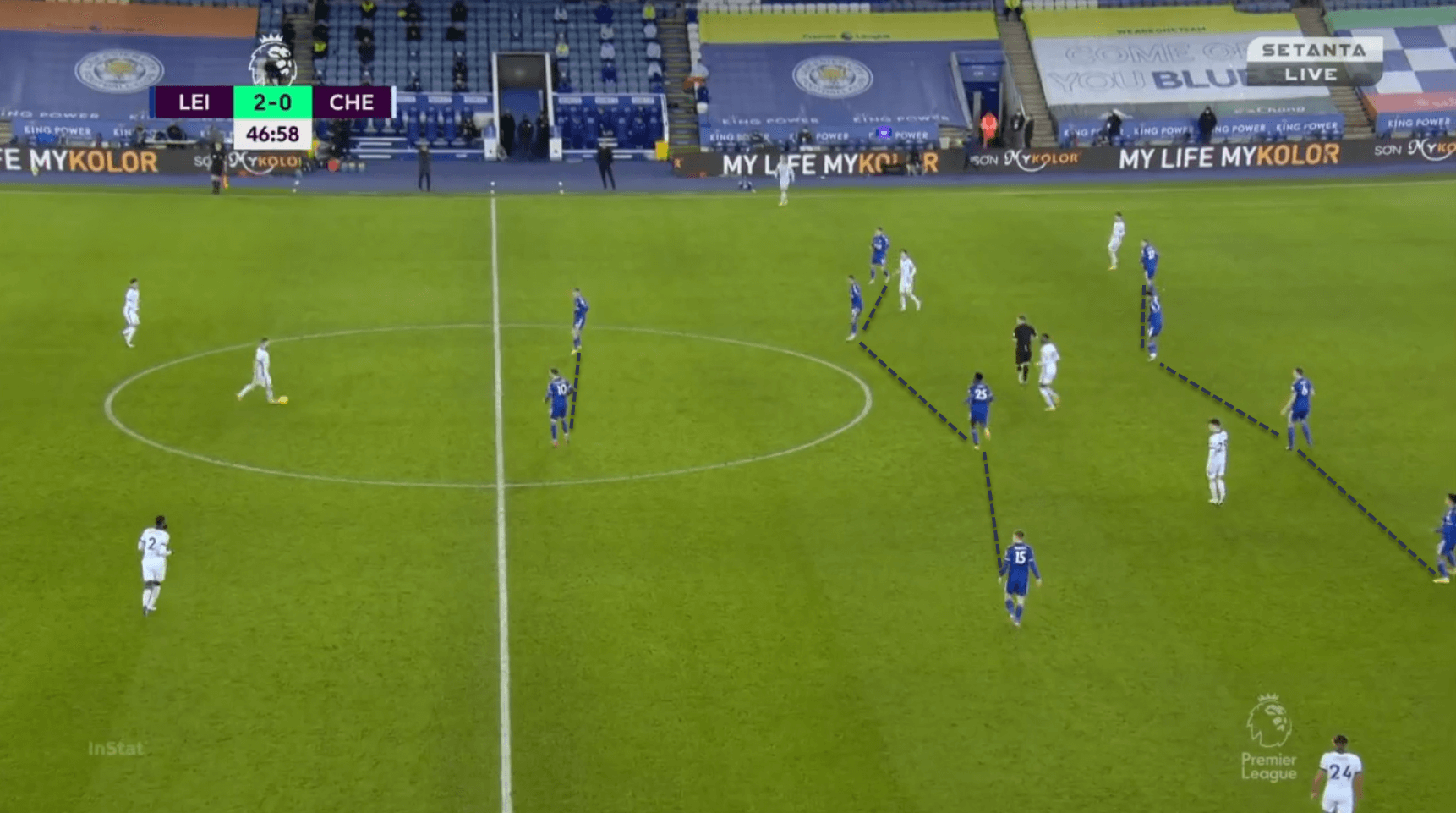
At times, Leicester have adopted a 4-4-2 shape without the ball, as seen here, with Maddison pushing up to join Vardy in order to screen the central space and prevent passes into the opposition’s central midfielders.
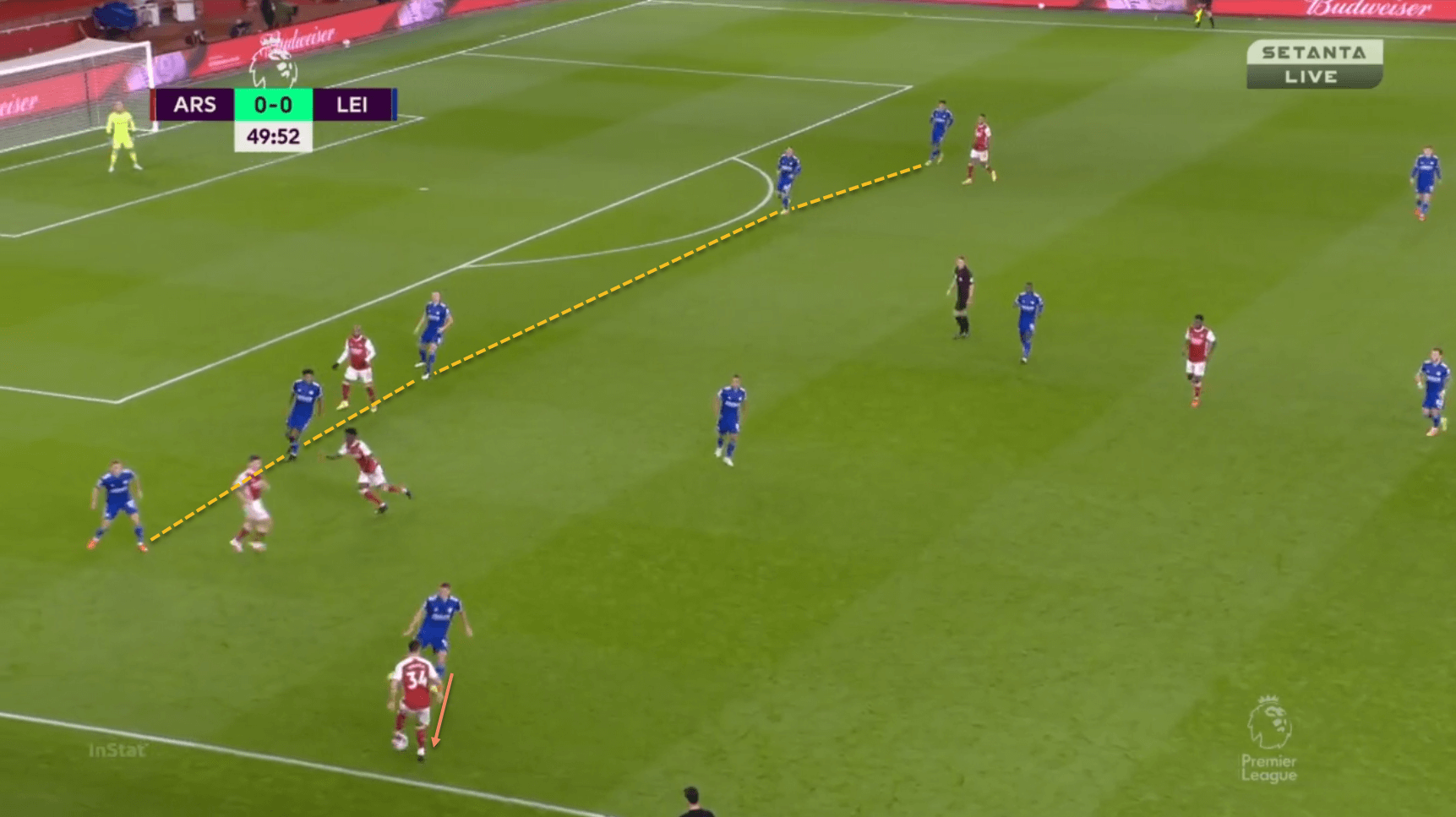
Finally, an example against Arsenal, with a similar back five and a compact midfield line. Note how the wide midfielder is going out to Granit Xhaka to engage him and not allow easy ball progression.
This has been a feature of Leicester’s play, with the team staying solid and compact in central areas, but also simultaneously working hard to shut down overloads and passing moves out wide. The back five has helped in this regard, as it allows the defence to cover a wider area of the pitch than a back four, while the work-rate of the midfielders should also be commended, as they have dropped into the wide areas when needed to carry out Rodgers’ tactical instructions.
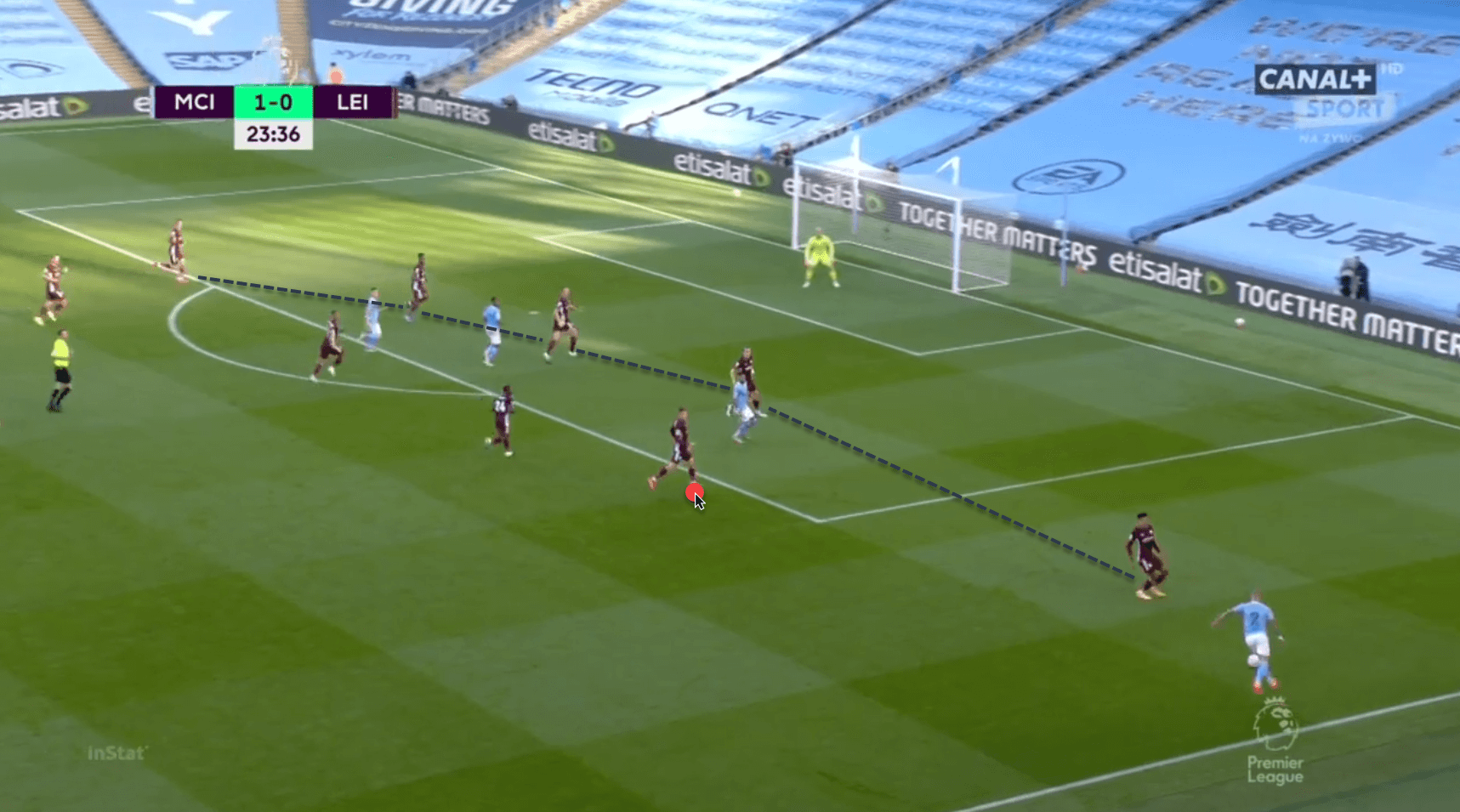
Here, James Justin, the left wing-back, is engaging Kyle Walker as he looks to deliver the cross, with Harvey Barnes staying central to stay close to Riyad Mahrez.
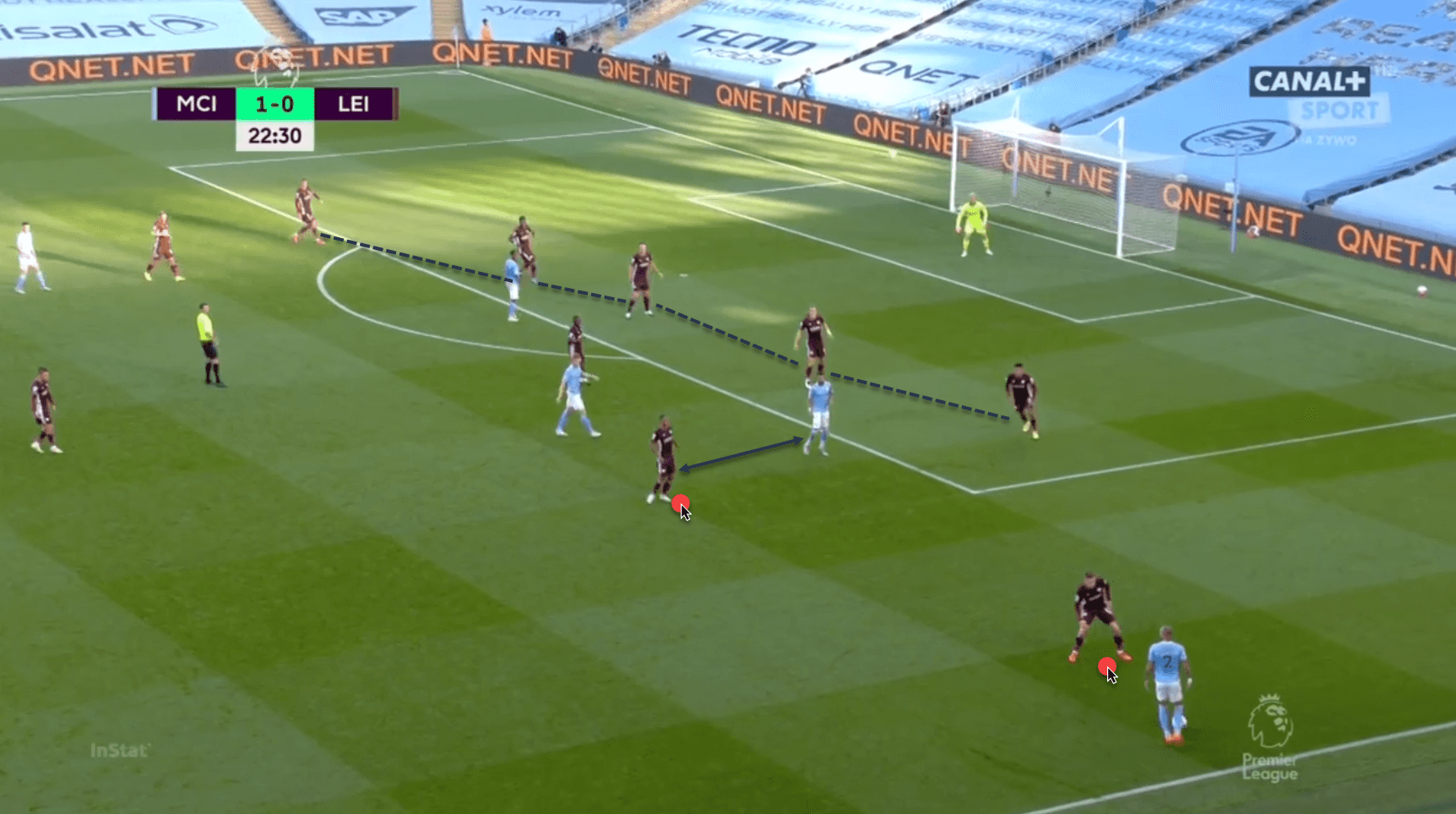
On this occasion, it is Barnes who has gone out wide to mark Walker, with Youri Tielemans staying central and close to Mahrez, and Justin also looking to step out to engage the Algerian.
Leicester’s commitment to defending the wider spaces has often led to them winning the ball back in those areas, allowing them to then spring quick counter-attacks.
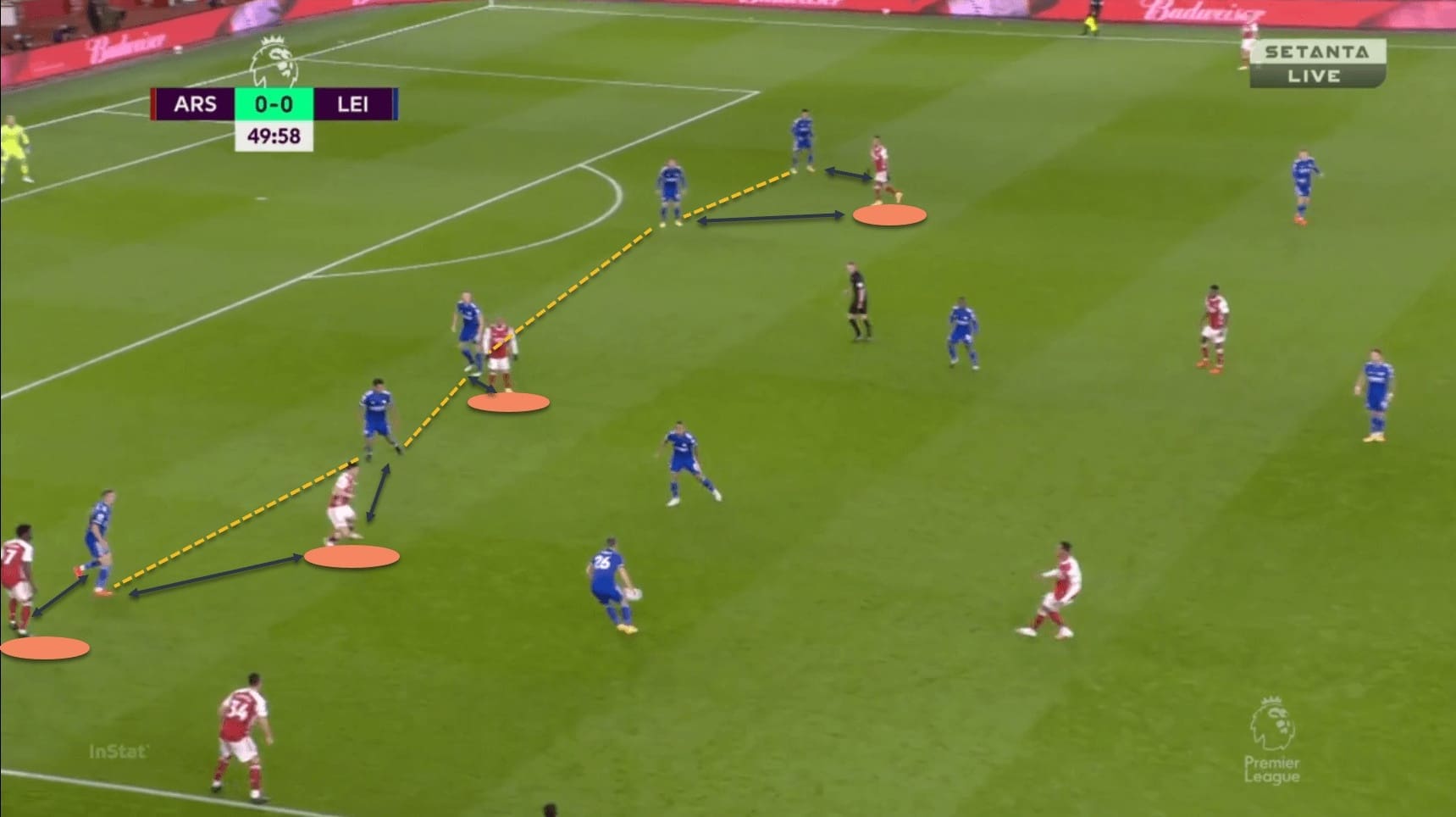
Note how all the Arsenal attackers in space here have at least one Leicester defender in close proximity. Gabriel plays the pass to Keiran Tierney, who miscontrolls and gives up possession, but even if he had been able to pick up the ball and turn, he would have found Wesley Fofana closing him down, with either of Dennis Praet or Tielemans also potentially in possession to help out if the Frenchman was able to hold up Tierney.
This is also a strategy seen higher up the pitch, where the Foxes look to shut off central passing options, and instead funnel the ball out wide. It is notable that Leicester are pressing far less than last season, as measured by the passes per defensive action (PPDA) metric. Last season, Leicester’s PPDA was the 3rd highest in the league, at 9.13. However, there has been a significant drop-off this season, with the Foxes’ PPDA having increased to 13.64, which is right at the middle of the Premier League. Of course, virtually every team is pressing much less this season, due to the effects of COVID-19 on the fixture schedule, but it is quite interesting that Rodgers has managed to maintain Leicester’s defensive solidity while completely changing their defensive approach and intensity.
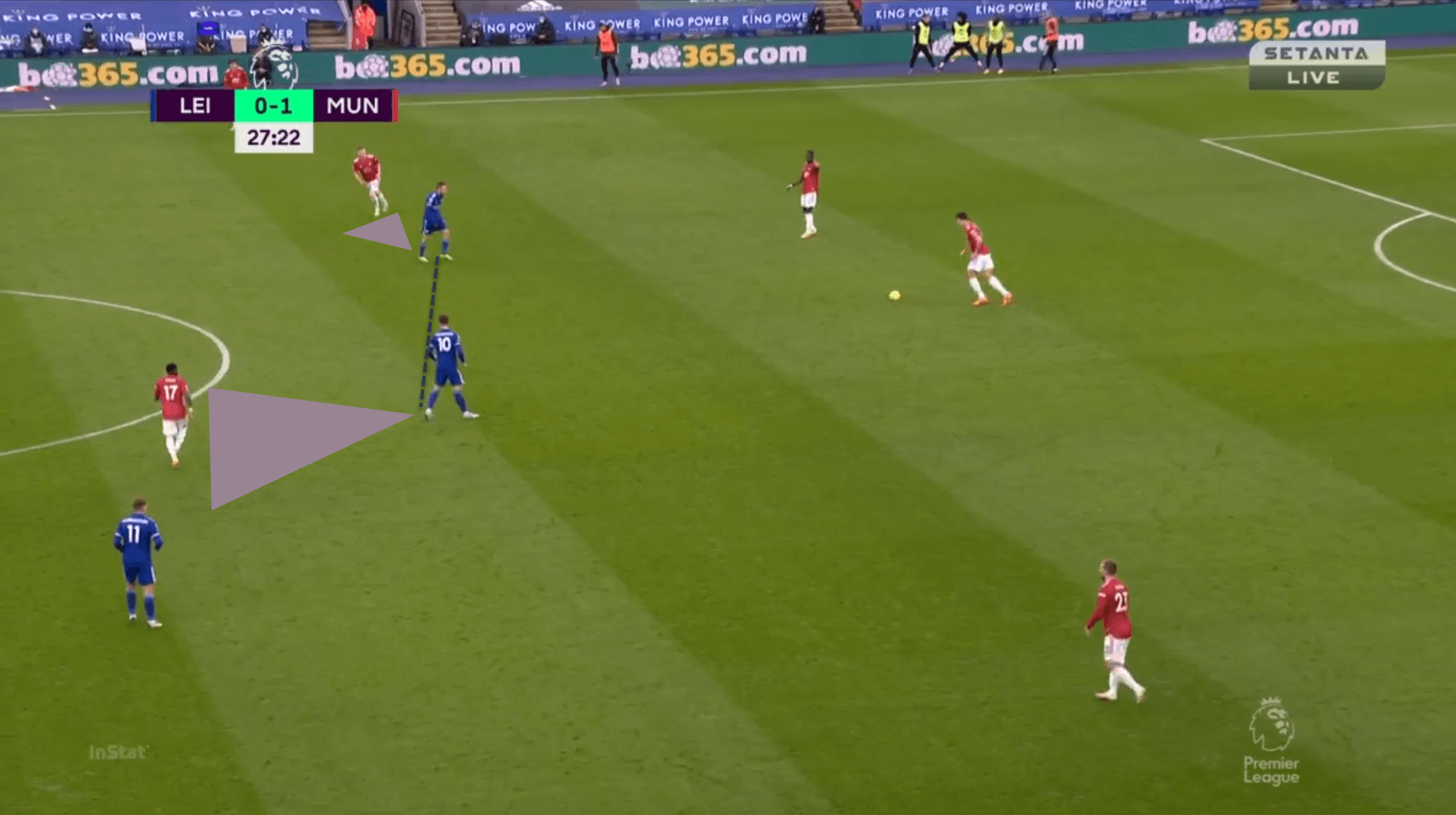
Note how Vardy and Maddison are content to drop off from the United centre-backs here, content to screen potential passes into Fred and McTominay instead, and therefore force the United centre-backs to go wide.
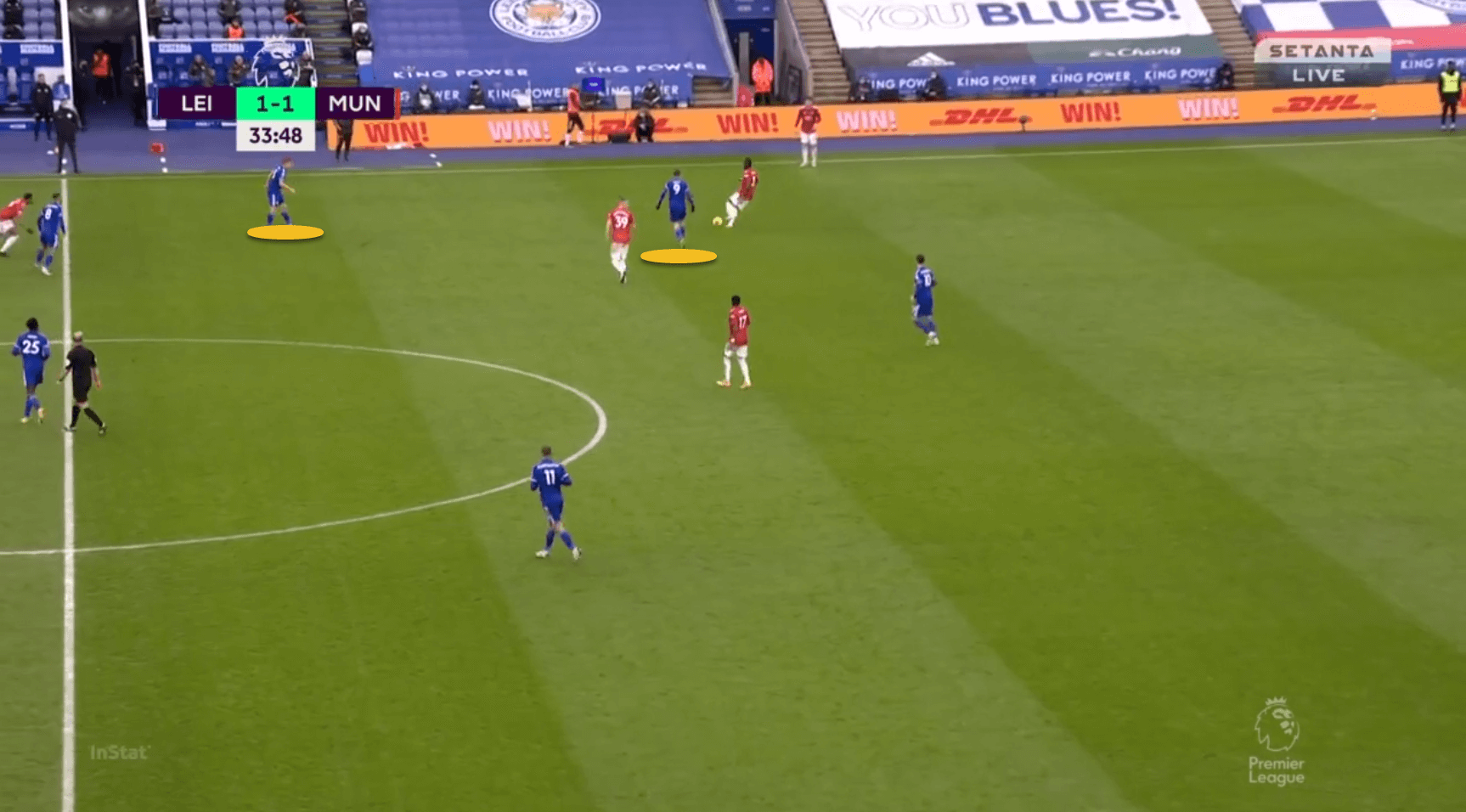
Leicester look to force opposition teams wide before trying to press, with the touchline acting as a natural barrier which reduces the available space for the player on the ball to play
Vardy is not looking to press Bailly here – he is instead gesturing to Barnes to stay ready to press when the ball is played out wide…
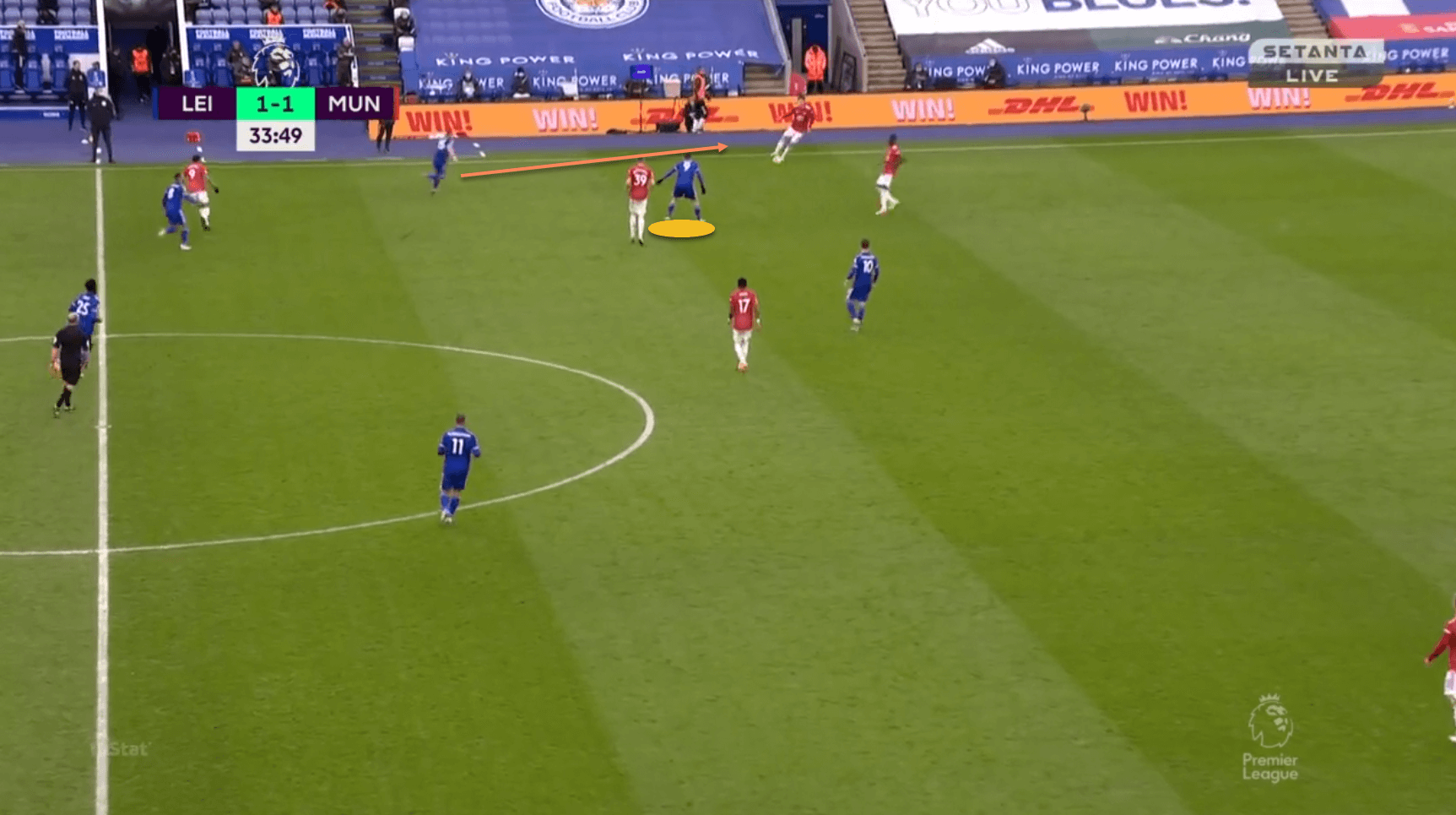
…which is exactly what happens, as the winger rushes towards Lindelof and Vardy blocks off the easy pass inside to McTominay.
These facets of their defensive play have been a big reason why Leicester have been a relatively solid team in the league this season. It has also helped in their offensive play, as we will see next.
Attacking play
Leicester may have a reputation as a counter-attacking side, but that would be doing this side a disservice. Rodgers has successfully managed to incorporate a blend of attacking tactics and strategies with this Leicester side, much like their defensive work. The Foxes are comfortable when being asked to break down low blocks, as well as when being able to play on the counter-attack. Again, similar to their defensive work, there are some key principles which remain consistent across these approaches, which have allowed them to be fluid in their attacking style of play this season.
One of the main tenets of Leicester’s approach while attacking, is an emphasis on rapid attacks. This is akin to a spring, recoiling and then springing forward when released, which is why it works well with their defensive approach as well, since they can absorb pressure and then quickly counter-attack into space. Even when they have the majority of possession, the emphasis is on working the ball around quickly to open up space in the opponent’s vertical or horizontal spacing, with quick one and two-touch passing and intelligent movement then to take advantage of it.
They have also looked to utilise the wider areas a lot while attacking, with players often making runs into those spaces, and the wingers looking to stay wide in the build-up phase to stretch the opposition’s lines.
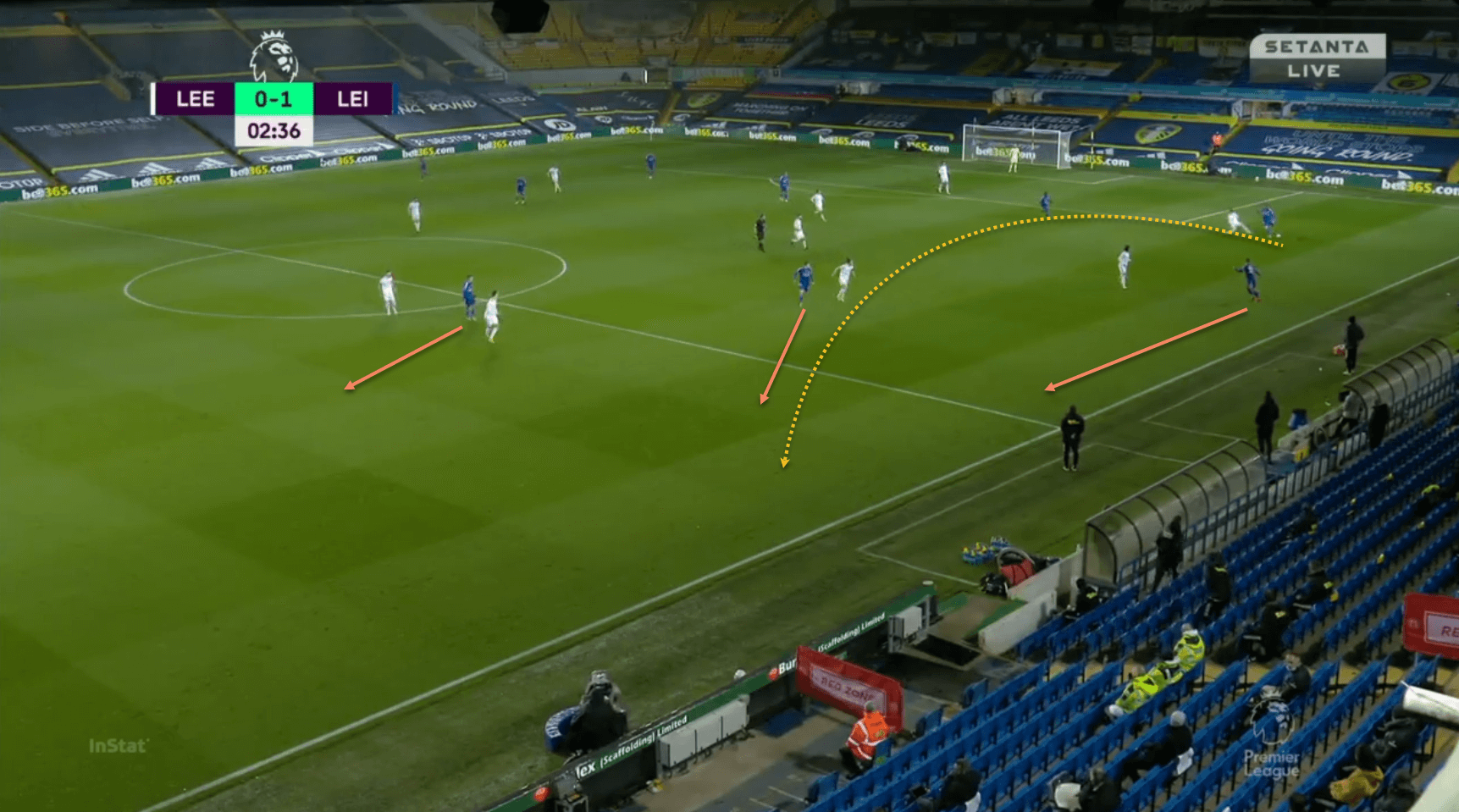
This is the build-up to Leicester’s opening goal against Leeds, where a pass into the wide spaces by Christian Fuchs set up the attack. Note how Jamie Vardy has space to run in behind, but also that Luke Thomas and Harvey Barnes end up attacking the pass from Fuchs into the left wing, helping create an overload, with Barnes then running infield to tuck in Vardy’s cross.
Another facet to their play has been their aggresiveness in trying to win the ball back, especially in midfield. Leicester may not be pressing as high as they were last season, but they are certainly attempting to win the ball back near the halfway line and then springing forward rapidly on the counter. On occasion, they are even challenging high up the pitch, as we saw in the build-up to their opening goal in the game against Manchester United.
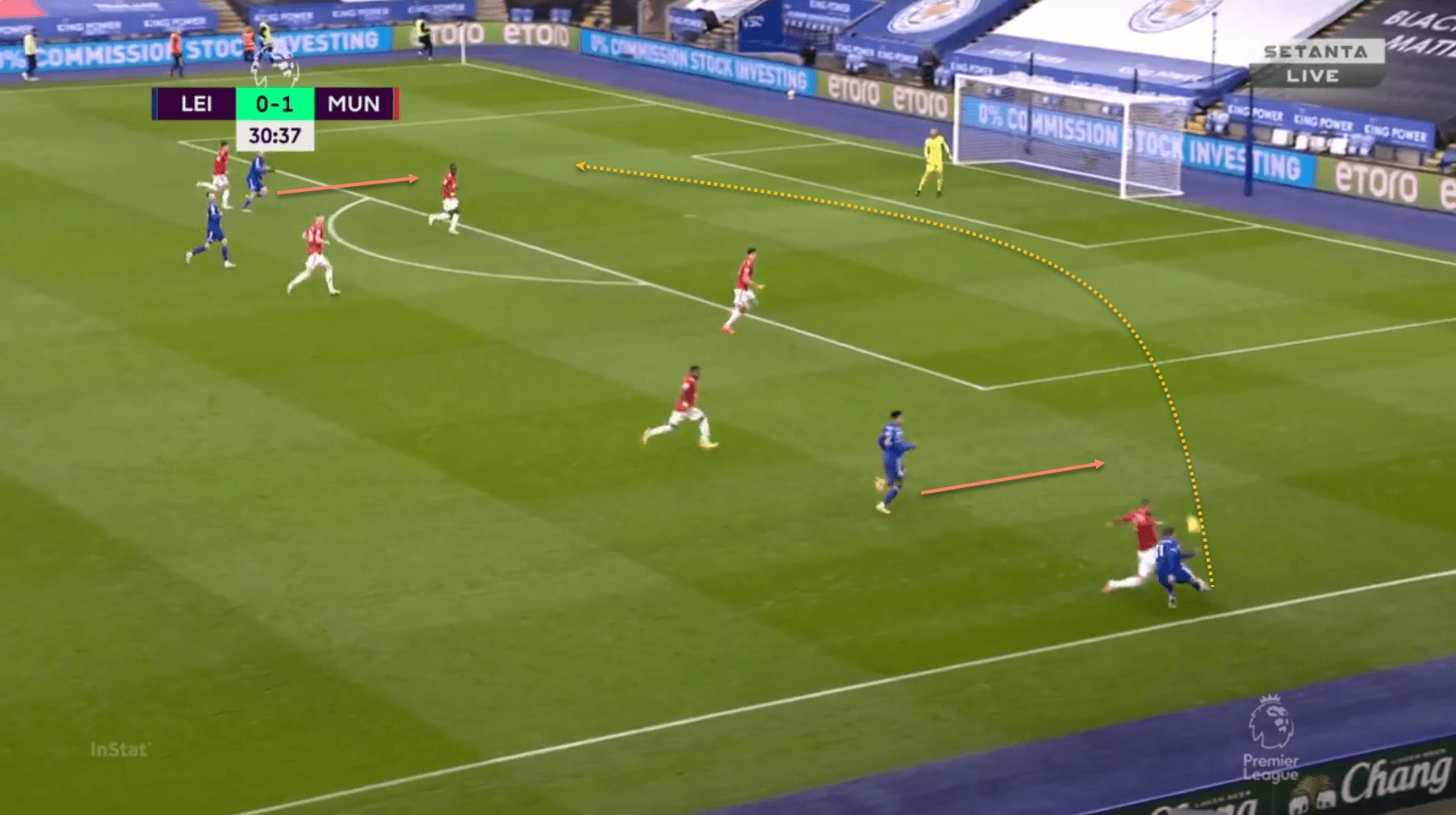
Here, Marc Albrighton sends in a cross from an extremely wide position on the right, with James Justin available on the overlap
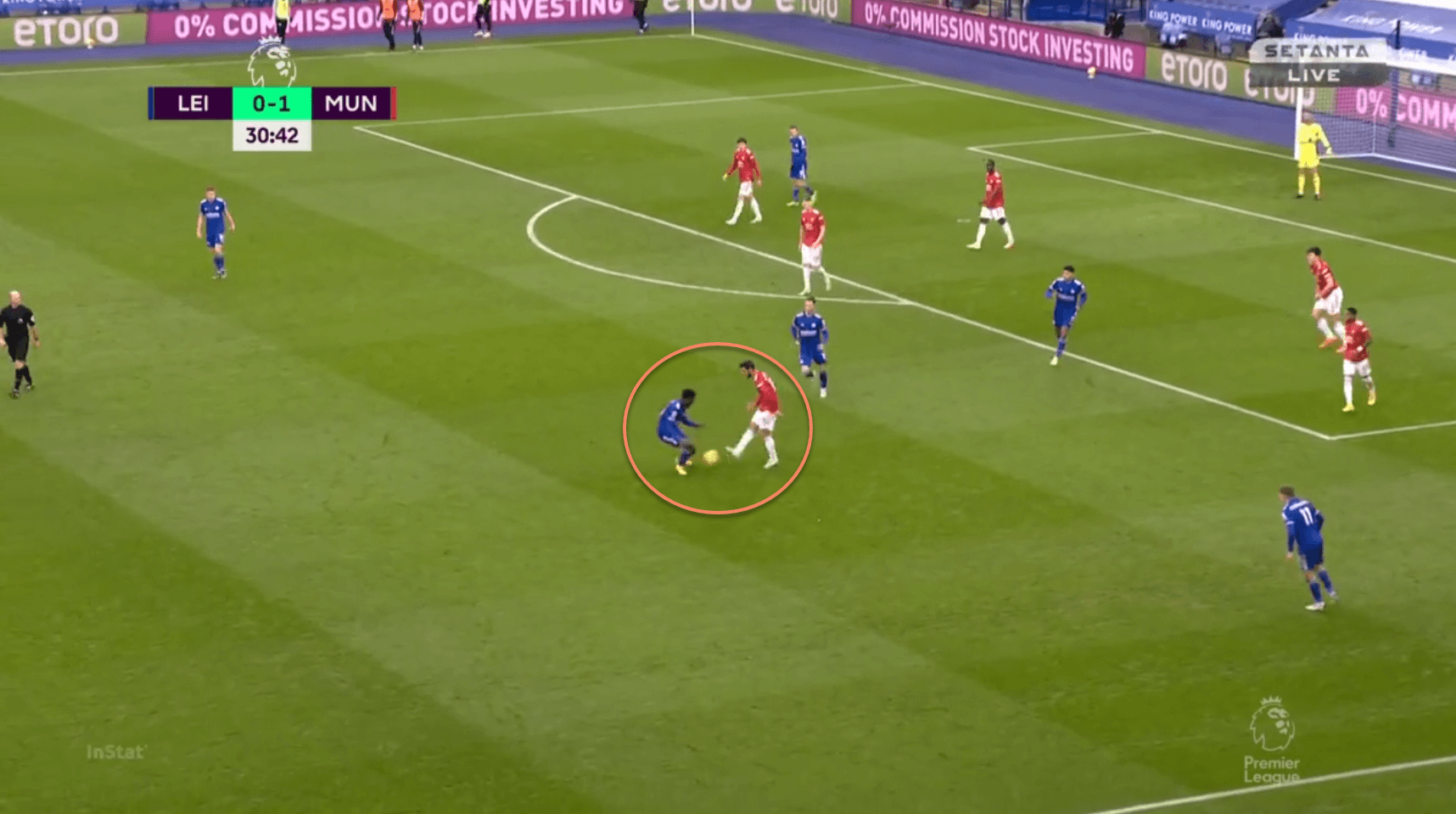
That initial cross is cleared, but when the ball lands at Bruno Fernandes’ feet, Wilfred Ndidi has pushed up onto him and wins the ball back…
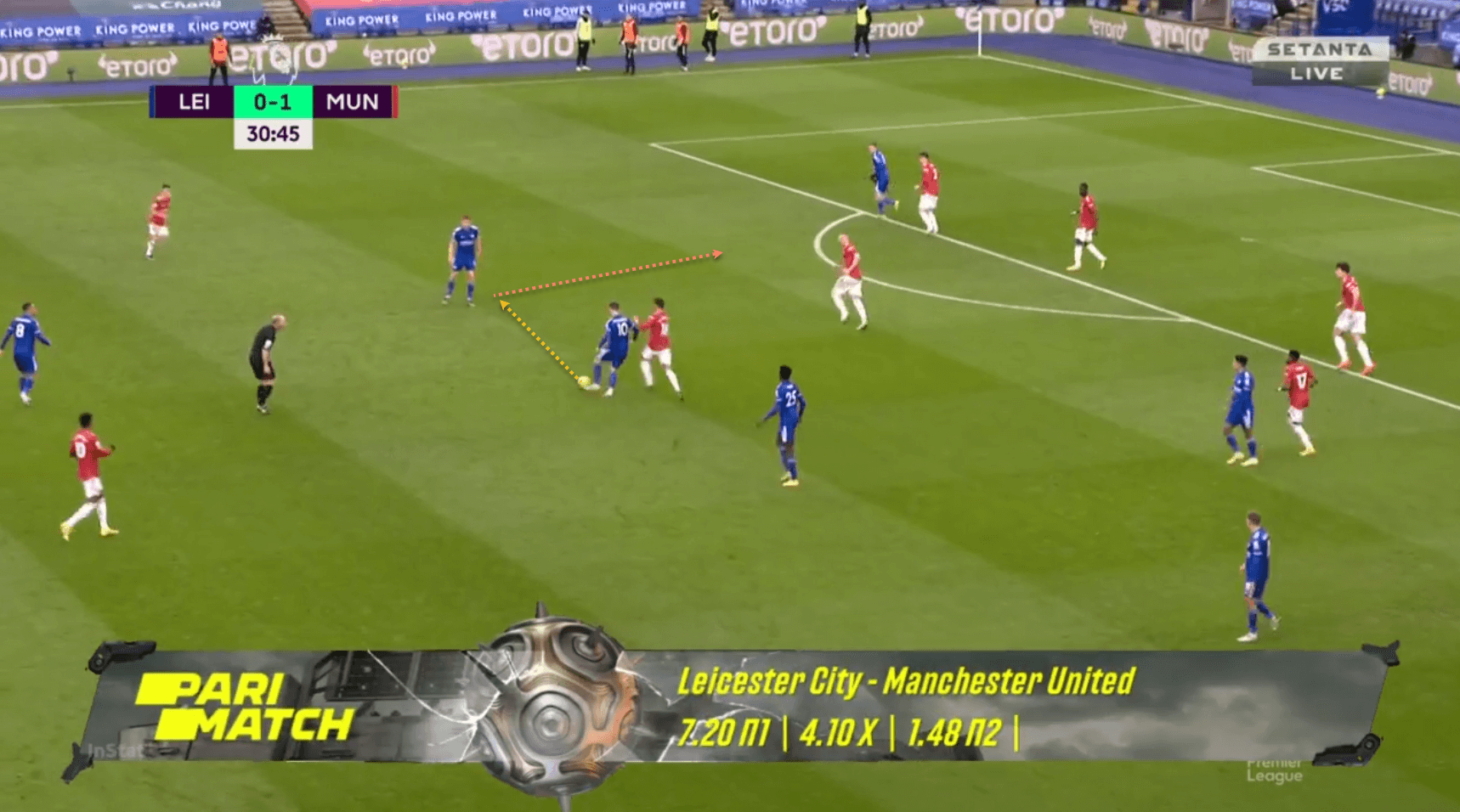
…moving it on to Maddison, who finds Barnes in a pocket of space, which he accelerates into to fire a shot into the net from outside the box
This has been a consistent feature of Leicester’s play, and has helped create several dangerous opportunities for them this season.
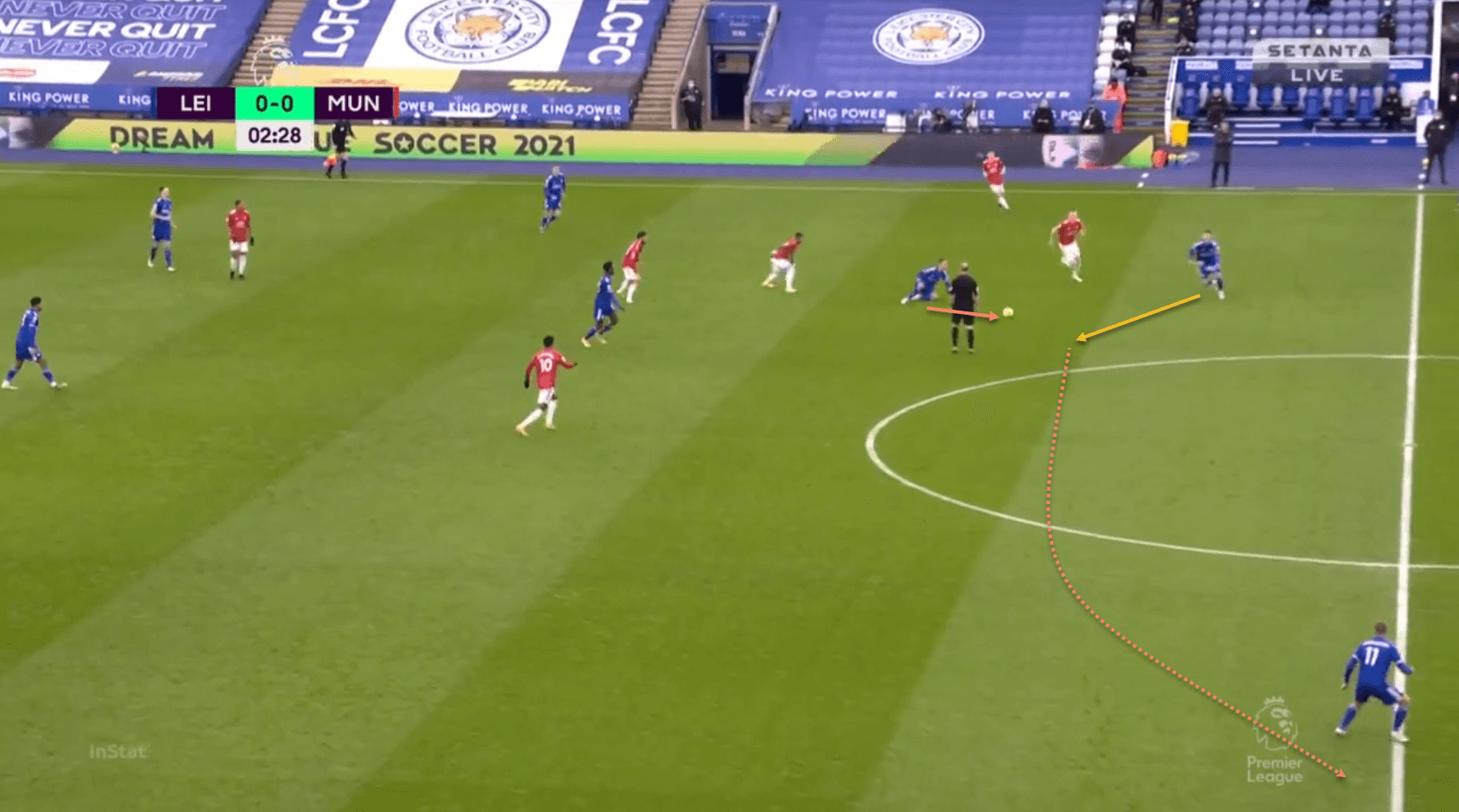
Another example from the United game, where the Foxes win the ball back near the halfway line. Maddison plays the ball out to Albrighton on the right…
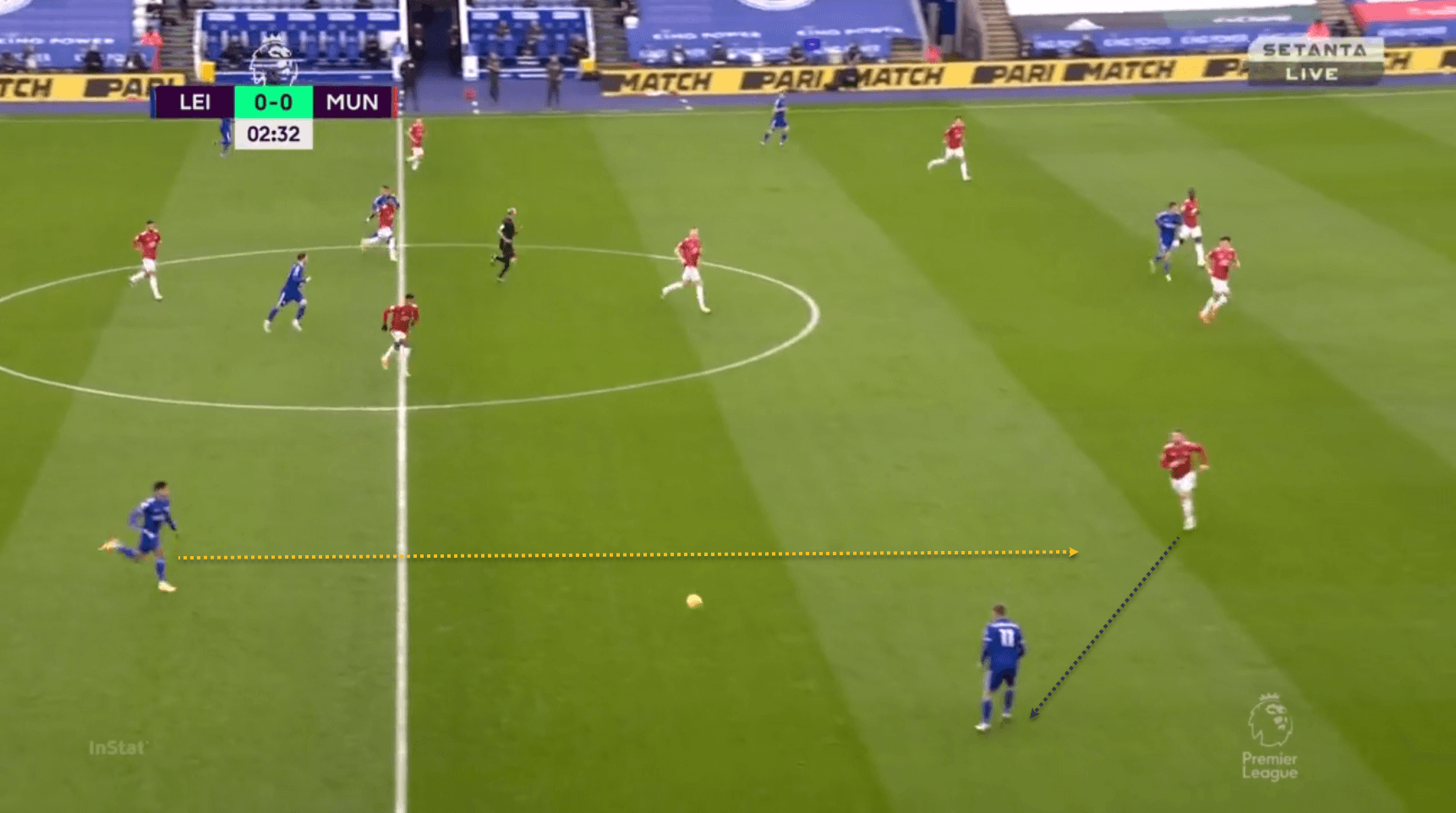
…who immediately has James Justin charging past him on the overlap, while his wide positioning has drawn Luke Shaw towards him
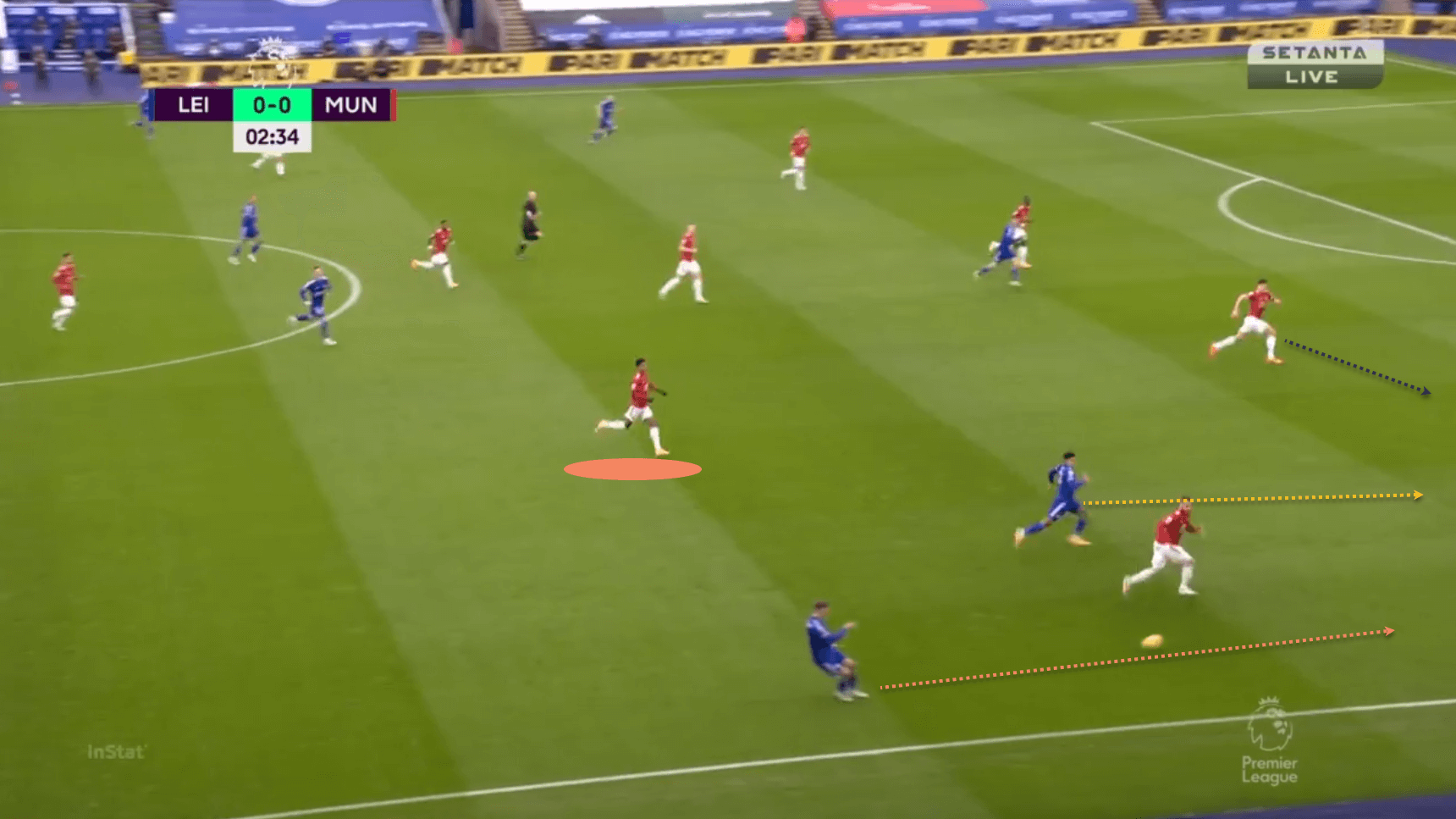
Marcus Rashford is unable to track Justin’s run, which gives Albrighton an easy pass to play to him in space, forcing Harry Maguire to move out to cover
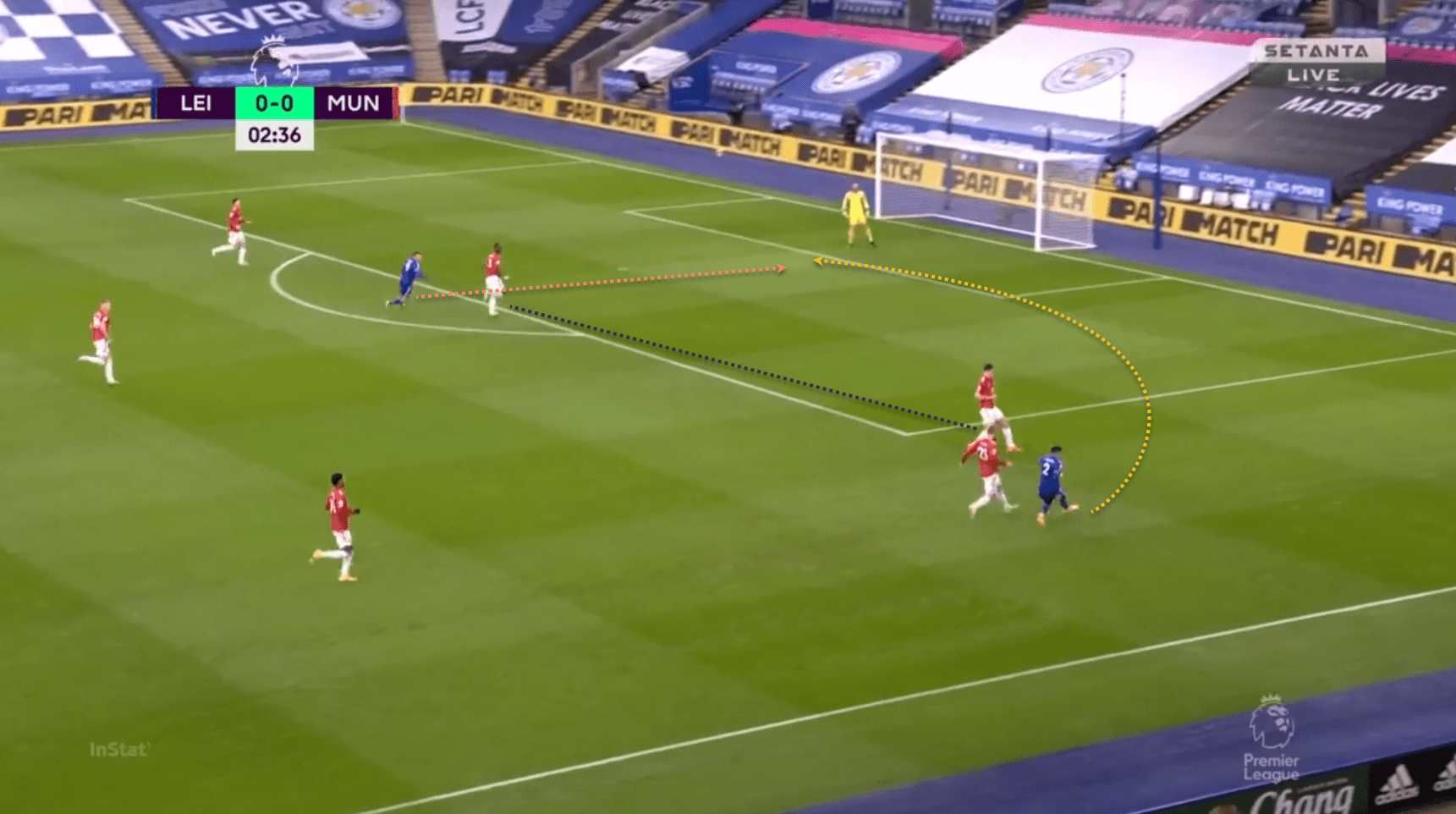
Justin puts in a whipped cross which Vardy heads over the bar, but note just how much space has been opened up between Bailly and Maguire. Maddison could have perhaps made a better effort to get into the box, which would have given Justin the chance to pull the ball back to an unmarked player in space on the edge of the box
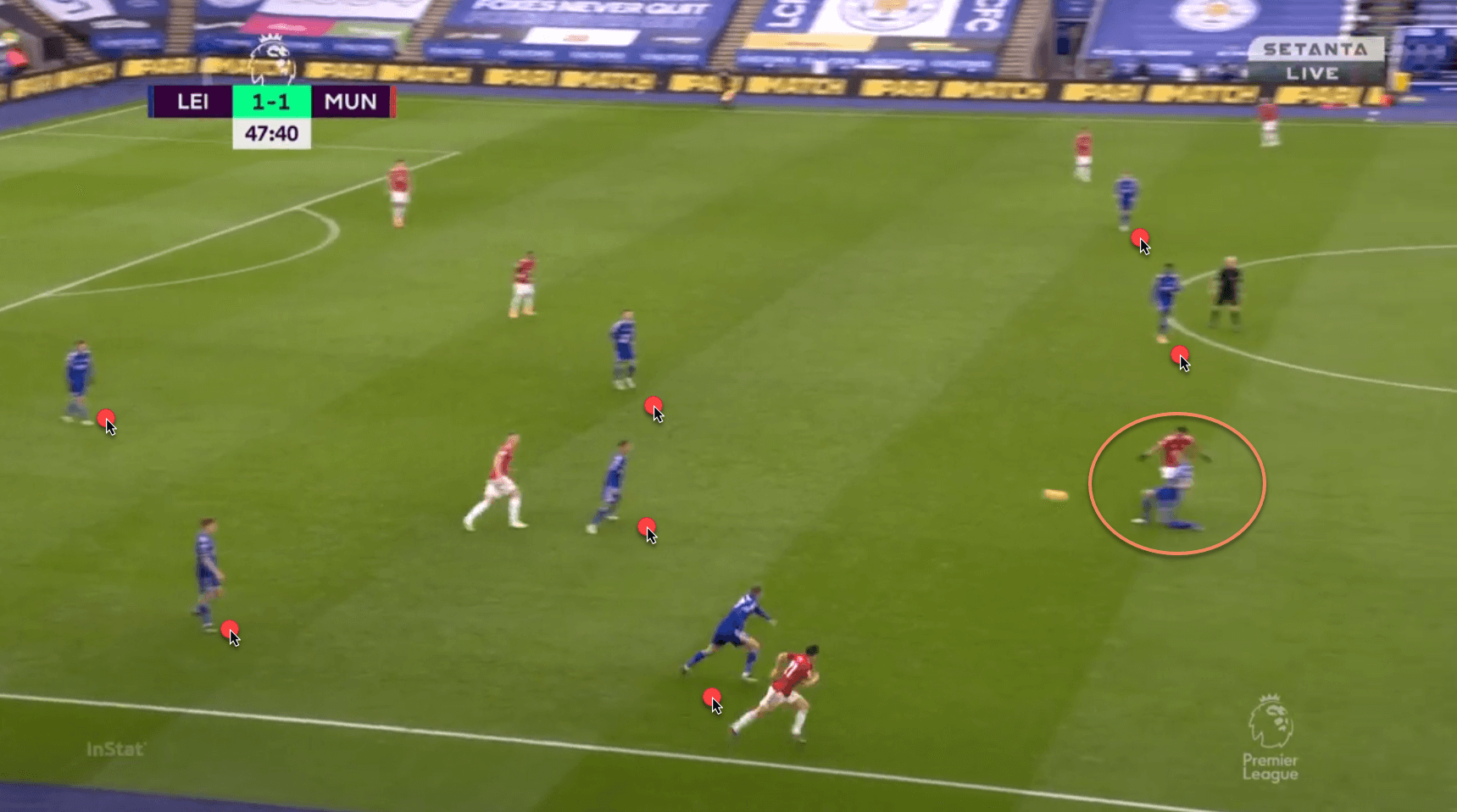
One final example from the game against United, where it is actually Jonny Evans who has stepped up from the backline and aggressively tackled Anthony Martial. Note just how many Leicester players are in a position to contribute to this attack – it did fizzle out on the opposite flank, but this is another instance where Leicester’s aggressive positioning and intensity in the challenge led to a promising situation offensively.
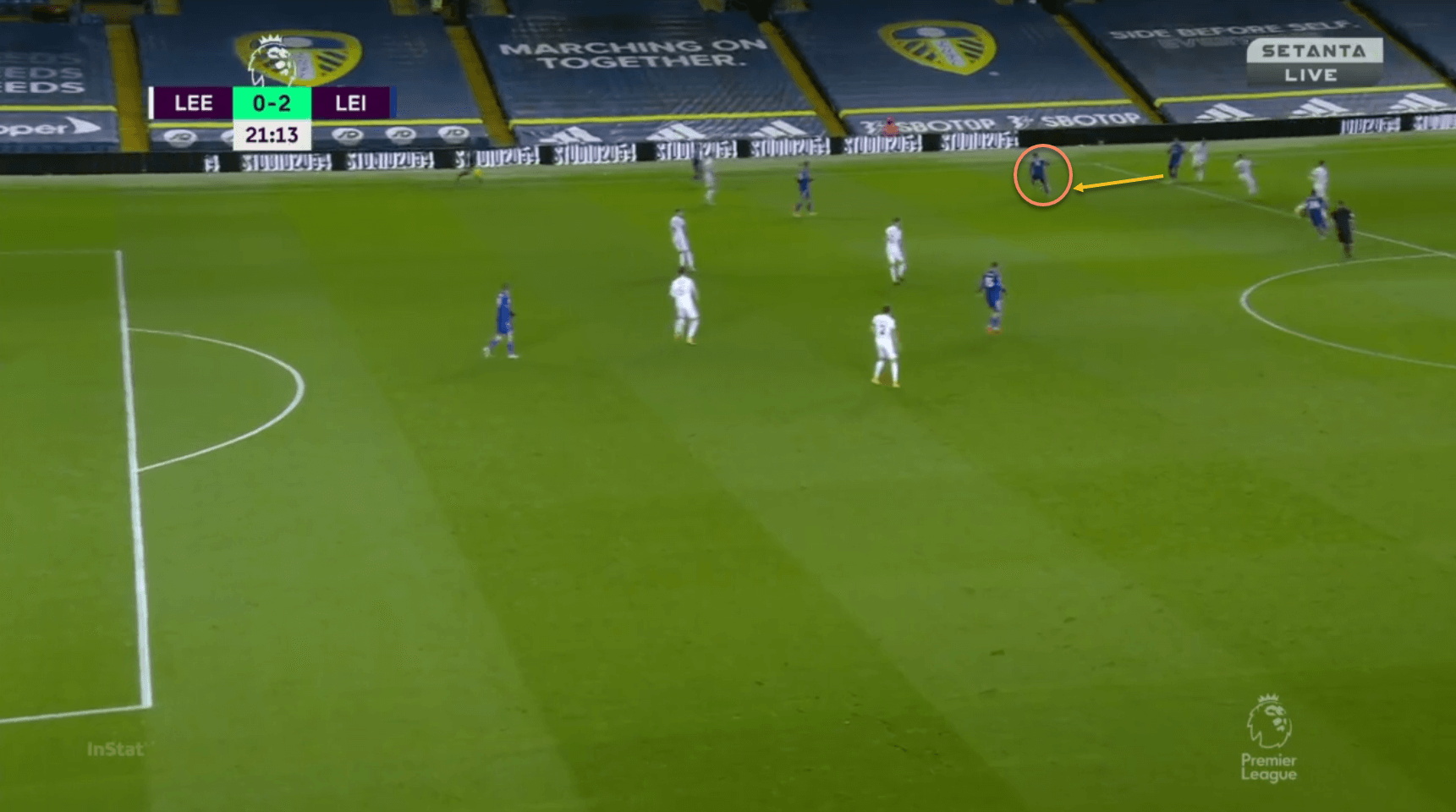
The Foxes’ second goal against Leeds came from such a situation – Ndidi wins the ball on the halfway line and passes to Tielemans, who is in oceans of space, and able to turn and run with the ball
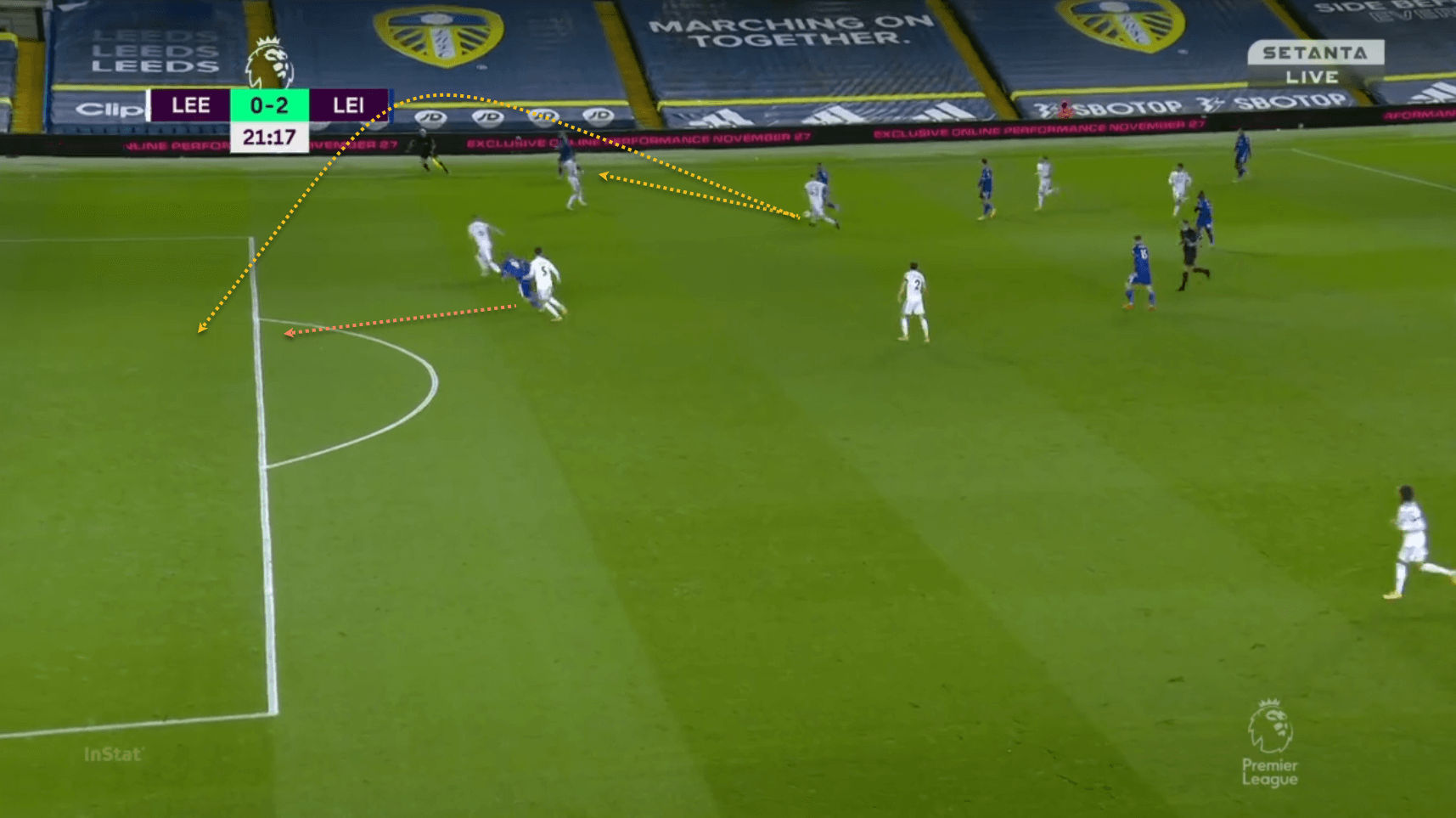
He then chooses to play the ball to Albrighton, who is wide on the right, despite Vardy making a run into the box and potentially able to latch on to a lofted ball over the top of the Leeds defence
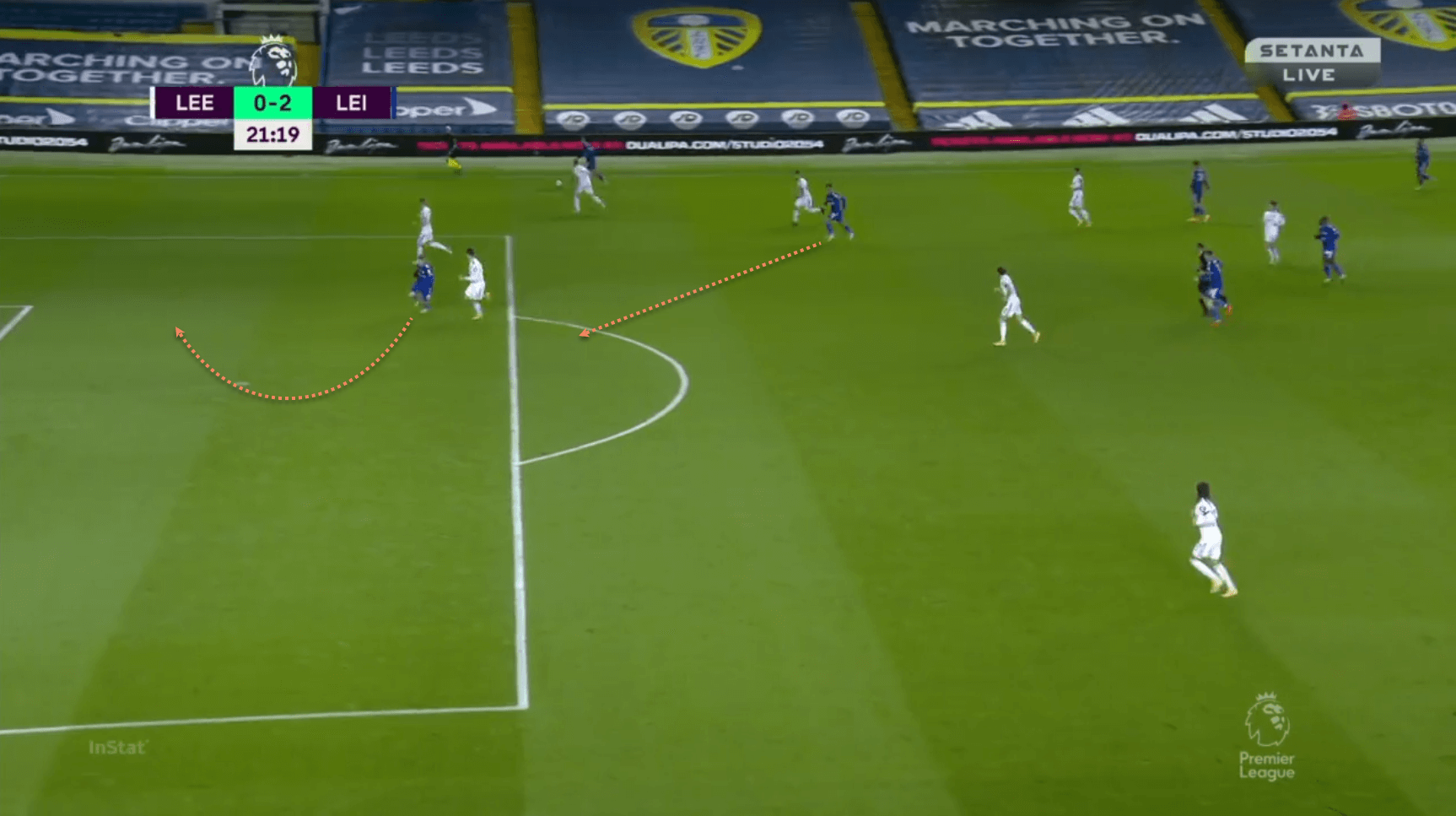
As Albrighton advances, Vardy’s movement in the box is excellent – he initially peels away towards the far post, dragging Robin Koch with him and separating him from Liam Cooper, before checking back and moving to the near post. Tielemans also starts to make a run into the box
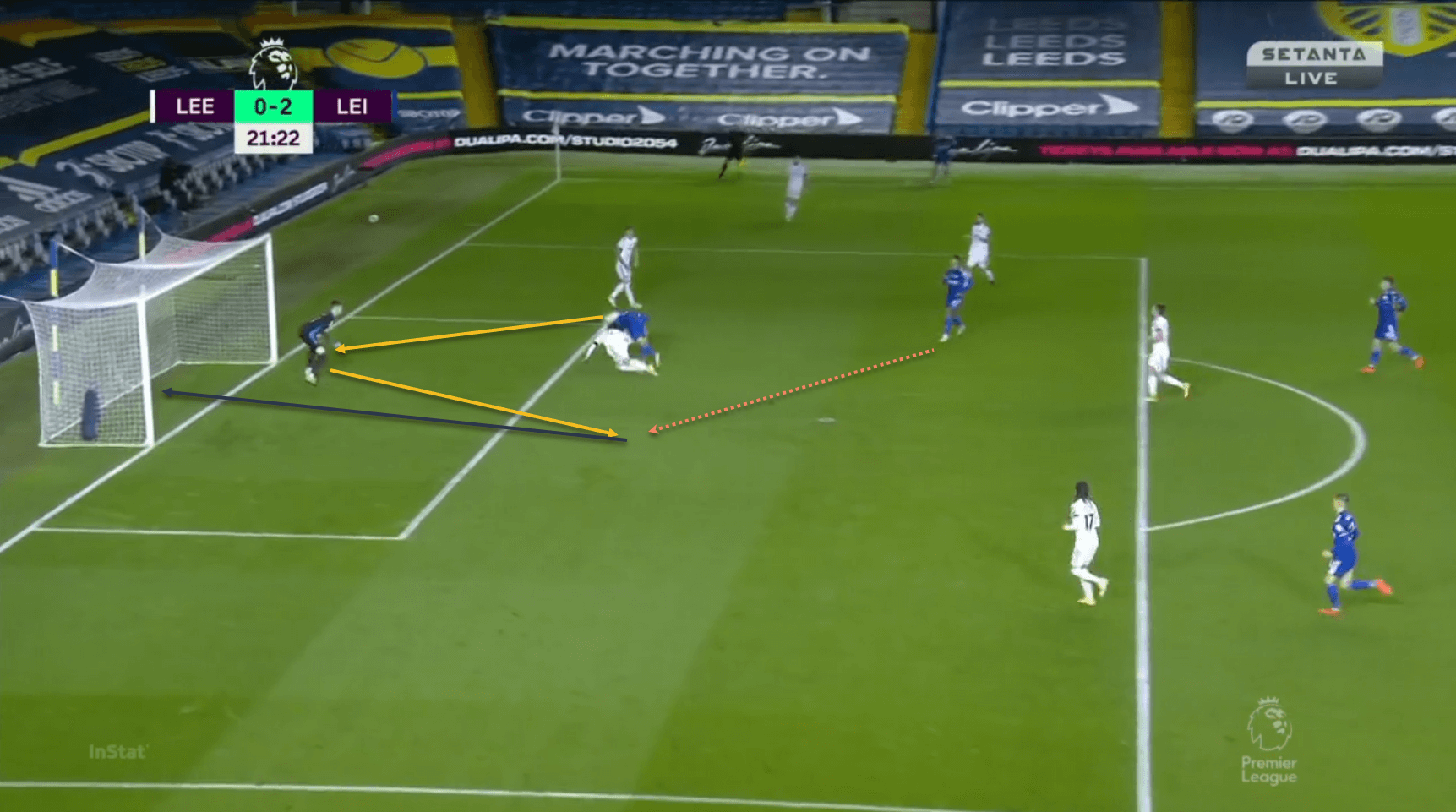
This movement allows the veteran to get ahead of Koch and place a header on target, which is spilled by Ilan Meslier, only for the onrushing Tielemans to pick up the ball and smash it into the net.
Thus, Leicester’s attacking approach this season has been based on intensity, usage of the wide areas, quick, early passing and a willingness to try and win the ball in the middle third of the pitch to then attack into space. This has been consistent, regardless of system or personnel, and is well-suited to the Leicester players as well, making it yet another intelligent tactical and coaching decision by Rodgers which has paid off.
Final thoughts
While some fans and observers may be surprised at Leicester’s lofty position in the Premier League table, those who have watched the side consistently over this season will know that it is not a false position. The Foxes’ play has been excellent, with defensive solidity married with attacking efficiency to create a team which has managed to do much better than the sum of its parts. Their approach has led to some statement wins, such as the 5-2 thrashing of Manchester City, the recent 2-0 win over Chelsea, a 4-1 win over Leeds, a 1-0 win over Arsenal and a 2-0 defeat of Tottenham. These results, along with their 2-2 draw against Manchester United, show how the side have been able to more than just hold their own against the traditional ‘Big Six’, and this is in large part due to their tactics, as well as some brilliant individual performances. Rodgers’ task is to now maintain this level of performance – the Foxes fell off alarmingly from a similar position last season in the second half of the campaign, and with Europa League football to come as well from February onwards, it will be interesting to see if Leicester are able to maintain their unlikely challenge for the title.





Comments